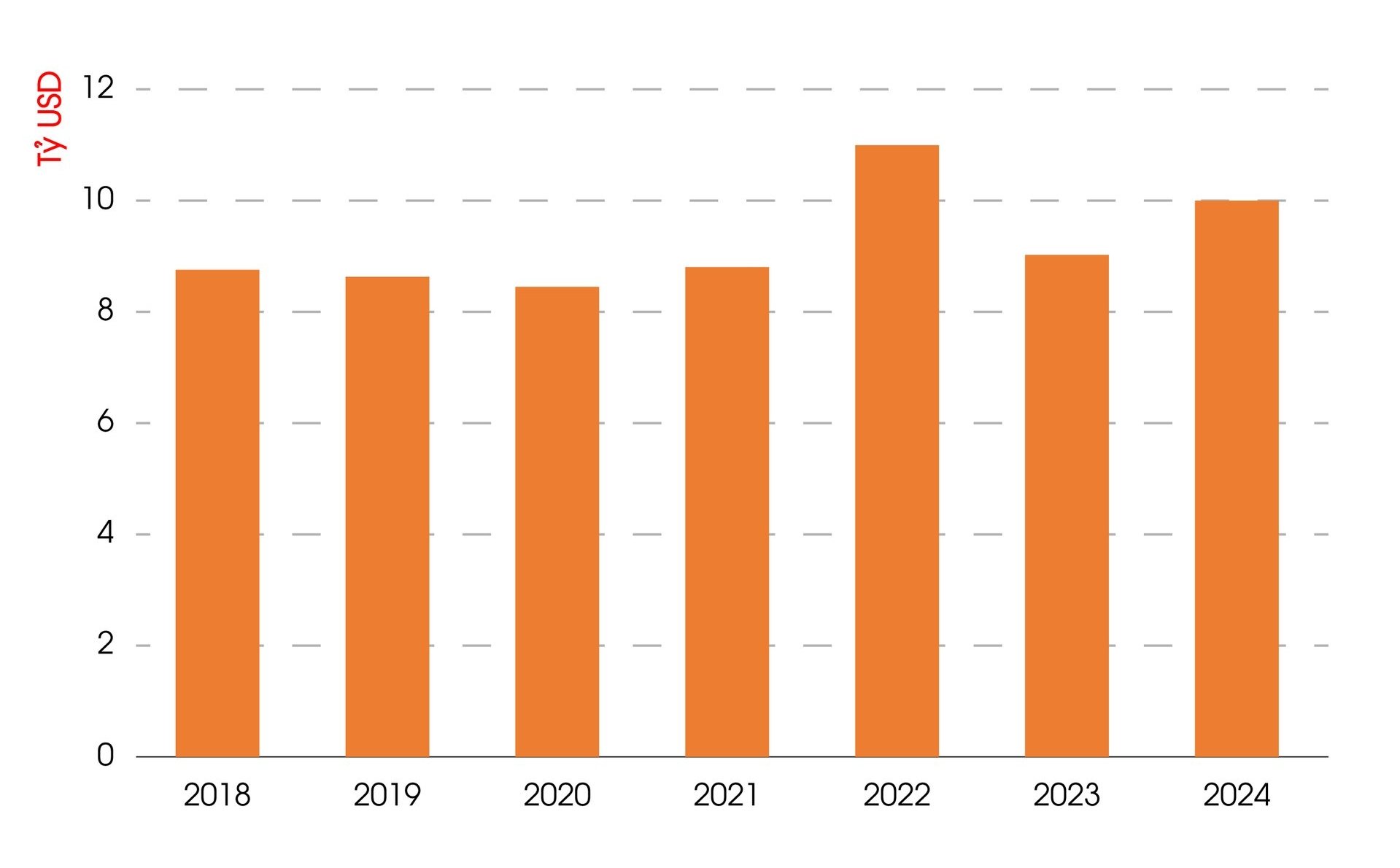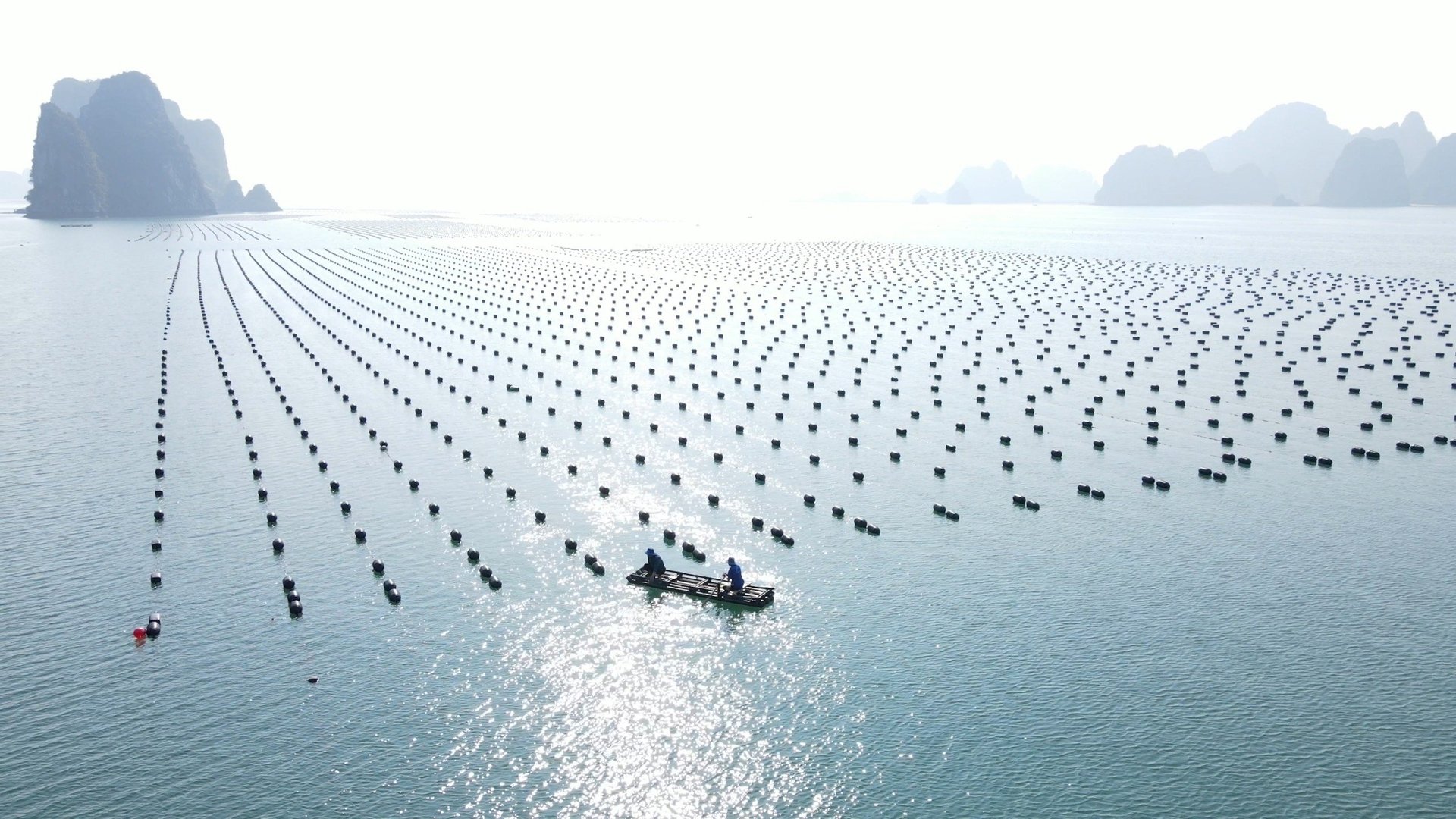October 19, 2025 | 14:29 GMT +7
October 19, 2025 | 14:29 GMT +7
Hotline: 0913.378.918
October 19, 2025 | 14:29 GMT +7
Hotline: 0913.378.918

Vietnam's seafood exports from 2018 to 2024. Sources: VASEP/ Chart: Hong Tham.
Vietnam has a coastline of over 3,260 km, an exclusive economic zone of about 1 million km², and more than 3,000 coastal islands plus the distant Hoang Sa and Truong Sa archipelagos. The South China Sea holds critical strategic significance, lying on the international maritime trade routes connecting the Pacific with the Indian Ocean, East with West, and Asia with the rest of the world.
These factors constitute Vietnam’s special advantage in developing its maritime economy in general and the fisheries sector in particular. They affirm its potential in exploitation, aquaculture, and processing while aligning with its mission to protect sovereignty, security, and ensure sustainable development.
In recent years, fisheries have held a particularly important place within the agricultural sector. Not only contributing to food security and livelihoods for millions of workers, fisheries also serve as a key economic pillar that has enabled Vietnam to extend its reach to the open sea and assert its national brand on the global export map.
According to the Vietnam Association of Seafood Exporters and Producers (VASEP), total seafood production rose steadily from 7.7 million tons in 2018 to 9.5 million tons in 2024, an increase of 23%, of which aquaculture accounted for 58% and capture fisheries 42%. Meanwhile, export turnover climbed from USD 8.8 billion in 2018 to USD 10 billion in 2024.
Thanks to its dynamism and innovation, overcoming many challenges, Vietnamese seafood products have been exported to over 170 markets, including stringent ones such as the EU, the US, Japan, China, South Korea, Australia, and the UK. Export turnover first exceeded USD 1 billion in 1999 and reached nearly USD 11 billion in 2022, ranking Vietnam among the top three seafood-exporting countries in the world (behind China and Norway).

The seafood industry continues to be identified as a key economic sector, with the goal of reaching USD 14 – 16 billion in annual export turnover. Photo: Hong Tham.
Mr. Tran Dinh Luan, Director General of the Directorate of Fisheries under the Ministry of Agriculture and Environment, stated that Vietnam currently ranks third globally in seafood exports, holding more than 7% of global market share, trailing only behind China and Norway.
Fisheries is not only a key economic sector contributing significantly to GDP and export turnover but also a major livelihood source for millions of fishermen and coastal farmers, deeply integrated into global supply chains and logistics.
Amid global fluctuations such as geopolitical competition, trade barriers, climate change and disease, the Vietnamese fisheries sector continues to show positive growth. In the first seven months of 2025 alone, total seafood output reached 5.5 million tons (up 3.1% year-on-year) and seafood exports are estimated at USD 6.2 billion (up 17%), reflecting a strong market recovery.
“These are highly encouraging results, affirming the trend of restructuring the sector toward modernization, sustainability and deep integration”, emphasized Director General Tran Dinh Luan.
He further indicated that fisheries remain a key economic pillar, with the goal of achieving USD 14–16 billion in export turnover annually while ensuring sustainable livelihoods for millions of workers.
To realize this target, the sector is focusing on five major orientations. First, it aims to develop sustainably, linking resource protection and biodiversity, with no environmental sacrifice for growth.
Second, the industry will promote industrial marine aquaculture, high-tech shrimp farming, and export-oriented pangasius farming, while modernizing offshore capture operations and reorganizing production through linkage and cooperation, as well as decisively ending illegal, unreported and unregulated (IUU) fishing to lift the EU “yellow card”.
Third, to reduce losses and enhance value addition, synchronized development of processing, preservation, fisheries logistics, and modern post-harvest systems will be pursued.
Fourth, export markets will be expanded in parallel with boosting domestic consumption, reinforcing the “Vietnamese Seafood” brand.
Finally, the sector will strongly apply science and technology, digital transformation, modern governance, and ESG (environmental, social, governance) social responsibility standards.
“This will be the guiding compass for Vietnam’s fisheries to develop sustainably, integrate internationally, and maintain its position as one of the world’s leading powers”, affirmed Director General Tran Dinh Luan.
Vietnamese fisheries have continuously asserted the strength of a vital economic sector. Today, as one of the world’s top three seafood-exporting countries, the sector not only carries the mission of national prosperity but also brings hope for a green, sustainable future, where each Vietnamese seafood product embodies nutritional value, brand identity, and the cultural essence of a confident maritime nation deeply integrated within the world.
Translated by Huong Giang
/2025/10/18/3400-0-nongnghiep-163353.jpg)
(VAN) Tilapia is experiencing strong growth, with export turnover in the first eight months of 2025 nearly tripling and gradually becoming a new key product of the fisheries sector.

(VAN) As gene editing has become a defining scientific frontier of modern agriculture, Viet Nam must soon establish a legal mechanism tailored to this technology to fully unlock its potential.
/2025/10/16/1254-2-145938_691.jpg)
(VAN) An expert from Hanoi University of Natural Resources and Environment has raised four barriers hindering Vietnam's progress toward achieving its target of net-zero emissions.

(VAN) Vietnam’s irrigation sector is shifting from manual operations to intelligent management, moving toward a modern, transparent, and climate-resilient water governance system.

(VAN) Acting Minister Tran Duc Thang agreed with Erex Group’s proposal and committed to supporting it, prioritizing resources, and assigning relevant agencies to take charge.

(VAN) On October 14, Deputy Prime Minister Tran Hong Ha chaired the 17th meeting of the National Steering Committee on Combating Illegal, Unreported and Unregulated (IUU) Fishing, connecting online with 21 coastal provinces and cities.

(VAN) Vietnam’s Ministry of Agriculture and Environment has identified four breakthroughs and six strategic solutions to advance green, sustainable growth and strengthen competitiveness in the new era of national development.